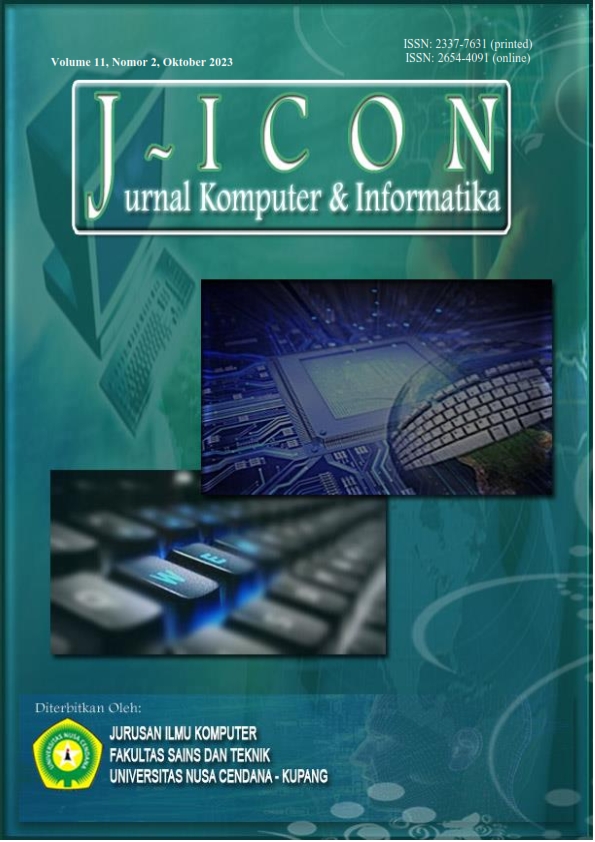MOBILE BASED APPLICATION OF AUGMENTED REALITY TECHNOLOGY AS A MEDIA FOR LEARNING QUR'AN RECITATION OF MAD LAW USING MDA FRAMEWORK METHOD
Abstract
Al-Qur'an recitation learning activities at several Quran Education Parks (TPQ), including TPQ Al-Asyraf, are conducted through face-to-face methods where teachers and students interact directly. These interactions often involve using books as the primary source of learning materials. Based on the observation activities, it has been identified that the direct teaching method has certain weaknesses, particularly when working with Generation Z students who are accustomed to enjoying multimedia resources in their daily lives. This research aims to implement marker based augmented reality technology in learning Al-Quran recitation. The media is designed to be based on mobile Android, the source material is taken from the book on the science of Tajwid written by K.H Imam Zarkasyi, one of the founders of Pondok Modern Gontor Ponorogo. The learning media concept is designed in the form of an augmented reality game following the mechanical, dynamic and aesthetic (MDA) Framework method, while the media design follows the steps of the software development life cycle (SDLC) method with the waterfall approach. This research resulted in the application "Belajar Tajwid" which contains examples of readings from each Mad's law in the form of three-dimensional animation. Testing is carried out through 4 stages, namely testing application features using the Black box method yielding a value of 100% and testing the suitability of the application with various android devices. Testing was also carried out by distributing questionnaires to an expert on Al-Qur'an recitation material with a score of 95%, a media expert with 90% and to potential users with an average score of 92%, so that the AR Learning Tajwid media was categorized as "appropriate" to be used as a new teaching media in learning recitation of Al-Qur’an .
Downloads
References
M. H. Ashadiqi, A. Erlansari, and F. Farady, “Aplikasi Pembelajaran Ilmu Tajwid Berbasis Android,” J. Rekursif, vol. 8, no. 1, 2020, doi: 10.33369/rekursif.v8i1.9641.
I. Zarkasyi, TAJWID. Ponorogo: TRIMURTI Press, 1995.
Z. Zen, “Inovasi Pendidikan Berbasis Teknologi Informasi : Menuju Pendidikan Masa Depan,” e-Tech J. Ilm. Teknol. Pendidik., vol. 6, no. 2, pp. 1–12, 2018, doi: 10.24036/et.v2i2.101346.
A. Pramono and M. D. Setiawan, “Pemanfaatan Augmented Reality Sebagai Media Pembelajaran Pengenalan Buah-Buahan,” INTENSIF J. Ilm. Penelit. dan Penerapan Teknol. Sist. Inf., vol. 3, no. 1, p. 54, 2019, doi: 10.29407/intensif.v3i1.12573.
A. Adhani, M. A. Gustalika, and I. K. A, “Penerapan Teknologi Augmented Reality Sebagai Media Pembelajaran Ilmu Tajwid Berbasis Android,” JURIKOM (Jurnal Ris. Komputer), vol. 9, no. 5, p. 1218, 2022, doi: 10.30865/jurikom.v9i5.4693.
L. Sari, “Penerapan Augmented Reality Sebagai Media Pembelajaran Pengenalan Ilmu Tajwid Berbasis Android,” J. Eng. Technol. Appl. Sci., vol. 4, no. 2, pp. 97–104, 2022, doi: 10.36079/lamintang.jetas-0402.386.
A. N. Anggraini, J. N. Fadila, and F. Nugroho, “Rancang Bangun Game 2D ‘Finding Tajwid’ Dengan Metode Finite State Mechine Menggunakan Software Unity Hub,” J. Teknol. Inf., vol. 5, no. 1, pp. 88–93, 2021, doi: 10.36294/jurti.v5i1.1782.
A. Darmanto, F. R. Pradhana, D. Muriyatmoko, O. V. Putra, and L. Effendi, “Implementation Of Augmented Reality Procedures For Prayer Using Marker-Based Tracking Method,” Procedia Eng. Life Sci., vol. 2, no. 1, pp. 1–6, 2021, doi: 10.21070/pels.v2i0.1169.
S. Aysiah, A. Komarudin, and R. Yuniarti, “Desain Game Edukasi Bertema Penerapan Akhlakul Karimah Menggunakan Framework Mechanics Dynamics Aesthetics,” Prosiding SISFOTEK, vol. 4, no. 1, pp. 281–286, 2020. [Online]. Available: www.seminar.iaii.or.id/index.php/SISFOTEK/article/view/234.
H. Setyawan, “Perancangan Sistem Pemandu Wisata Sebagai Media Informasi Dengan Memanfaatkan Augmented Reality (Studi Kasus: Museum Galeri Nasional,” Digilib Esa unggul, 2019. [Online]. Available: digilib.esaunggul.ac.id/public/UEU-Undergraduate-10997-Jurnal.Image.Marked.pdf
Kh. Imam Zarkasyi, Pelajaran Tajwid Qa’idah Bagaimana Mestinya Membaca Al-Qur’an untuk pelajaran permulaan. TRIMURTI PRESS, 2001.
Y. Bassil, “A Simulation Model for the Waterfall Software Development Life Cycle,” International Journal of Engineering and Technology, vol. 2, no. 5, May 2012.
Feradhita NKD, “Pengertian, Model, dan Tahapan SDLC (Software Development Life Cycle),” blog, 2021. [Online]. Available: www.logique.co.id/blog/2021/04/28/tahapan-sdlc/.
A. Arif, S. Bin Lahuri, W. Alfaridsi Achmad Zein, D. Muriyatmoko, N. Faizin, and A. Budiman, “Penerapan Gamifikasi Mechanics, Dynamics and Aesthetics Untuk Pengenalan Mawaris Berbasis Mobile,” Pros. SemNas UNIMUS, vol. 5, pp. 63–75, 2022. [Online]. Available: prosiding.unimus.ac.id/ index.php/semnas/article/view/1080
Gamelab Indonesia, “Mengenal MDA Framework: Mechanics, Dynamics, dan Aesthetics,” 2020.
A. B. Kusuma and N. Hadinata, “The Implementation of the Black Box Method for Testing Smart Hajj Application Ministry of Religion,” J. Inf. Syst. Informatics, vol. 4, no. 3, pp. 673–686, 2022, doi: 10.51519/journalisi.v4i3.306.
Copyright (c) 2023 Faisal Reza Pradhana, Aziz Musthafa, Firmana Putra

This work is licensed under a Creative Commons Attribution 4.0 International License.
The author submitting the manuscript must understand and agree that if accepted for publication, authors retain copyright and grant the journal right of first publication with the work simultaneously licensed under a Creative Commons Attribution (CC-BY) 4.0 License that allows others to share the work with an acknowledgment of the work’s authorship and initial publication in this journal.
 Faisal Reza Pradhana(1*)
Faisal Reza Pradhana(1*)




